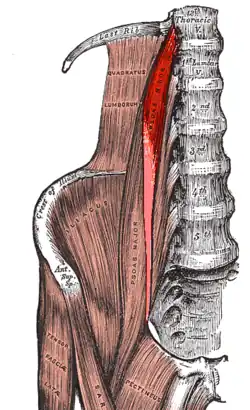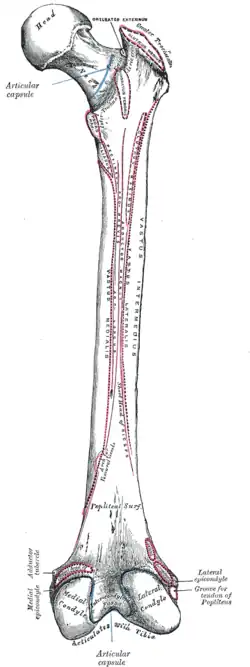Psoas minor muscle
| Psoas minor muscle | |
|---|---|
 Muscles of the iliac and anterior femoral regions (psoas minor visible near top right) | |
| Details | |
| Origin | Lateral surface bodies of T12 and L1 vertebrae and intervening intervertebral disc |
| Insertion | Pectineal line and iliopubic eminence |
| Nerve | Anterior ramus of nerve L1 |
| Actions | Weak trunk flexor |
| Antagonist | Erector Spinae |
| Identifiers | |
| Latin | Musculus psoas minor |
| TA98 | A04.7.02.005 |
| TA2 | 2596 |
| FMA | 22350 |
| Anatomical terms of muscle | |
The psoas minor muscle is a long, slender skeletal muscle.[1][2] When present, it is located anterior to the psoas major muscle.[1][2]
Structure
The psoas minor muscle originates from the vertical fascicles inserted on the last thoracic and first lumbar vertebrae. From there, it passes down onto the medial border of the psoas major, and is inserted to the innominate line and the iliopectineal eminence. Additionally, it attaches to and stretches the deep surface of the iliac fascia and occasionally its lowermost fibers reach the inguinal ligament.[3] It is posteriolateral to the iliopsoas muscle.[4] Variations occur, however, and the insertion on the iliopubic eminence sometimes radiates into the iliopectineal arch.[5]
The psoas minor muscle receives oxygenated blood from the four lumbar arteries (inferior to the subcostal artery) and the lumbar branch of the iliolumbar artery.
Innervation
The psoas minor muscle is innervated by direct branches of the lumbar spinal nerves.[6]
Variation
The psoas minor muscle is considered inconstant and is often absent, only being present in about 40% of human specimens studied.[7] It has an average length of about 24 cm, of which about 7.1 cm is muscle tissue and about 17 cm is tendon.
Function
The psoas minor is a weak flexor of the lumbar vertebral column.
Other animals
The psoas minor muscle is present in other mammals, such as horses.[8] In horses, it may be palpated during rectal exams to check for causes of back pain.[8]
Additional images
 Right hip bone, internal surface
Right hip bone, internal surface Right femur, posterior surface
Right femur, posterior surface Psoas minor muscle
Psoas minor muscle Psoas minor muscle
Psoas minor muscle Psoas minor muscle
Psoas minor muscle
Notes
- 1 2 Tank (2005), p 93
- 1 2 Gray (2008), p 1372
- ↑ Bendavid (2001), p 58
- ↑ Zwingenberger, Allison; Benigni, Livia; Lamb, Christopher R. (2015-01-01), Mattoon, John S.; Nyland, Thomas G. (eds.), "Chapter 14 - Musculoskeletal System", Small Animal Diagnostic Ultrasound (Third Edition), St. Louis: W.B. Saunders, pp. 517–540, ISBN 978-1-4160-4867-1, retrieved 2021-01-22
- ↑ Platzer (2004), p 234
- ↑ Gardner, ERNEST D.; Bunge, RICHARD P. (2005-01-01), Dyck, Peter J.; Thomas, P. K. (eds.), "Chapter 2 - Gross Anatomy of the Peripheral Nervous System", Peripheral Neuropathy (Fourth Edition), Philadelphia: W.B. Saunders, pp. 11–33, ISBN 978-0-7216-9491-7, retrieved 2021-01-22
- ↑ Mcg Farias (1 Jan. 2012). Morphological and morphometric analysis of Psoas Minor Muscle in cadavers. ResearchGate. Retrieved from https://www.researchgate.net/publication/280236296_Morphological_and_morphometric_analysis_of_Psoas_Minor_Muscle_in_cadavers
- 1 2 Haussler, Kevin K.; Jeffcott, Leo B. (2014-01-01), Hinchcliff, Kenneth W.; Kaneps, Andris J.; Geor, Raymond J. (eds.), "21 - Back and pelvis", Equine Sports Medicine and Surgery (Second Edition), W.B. Saunders, pp. 419–456, ISBN 978-0-7020-4771-8, retrieved 2021-01-22
References
| Wikimedia Commons has media related to Psoas minor muscles. |
- Bendavid, Robert; Abrahamson, Jack; Arregui, Maurice E. (2001). Abdominal Wall Hernias: Principle and Management. Springer. ISBN 0-387-95004-4.
- Platzer, Werner (2004). Color Atlas of Human Anatomy, Vol 1: Locomotor system (5th ed.). Thieme. ISBN 3-13-533305-1. (ISBN for the Americas 1-58890-159-9.)
- Tank, Patrick W. (2005). Grant's Dissector (13th ed.). Hagerstown, MD: Lippincott Williams & Wilkins. ISBN 0-7817-5484-4.
- Gray, Henry; Standring, Susan (2008). Gray's Anatomy - The Anatomical Basis of Clinical Practice (40th ed.). Churchill Livingstone - Elsevier. ISBN 978-0-443-06684-9.